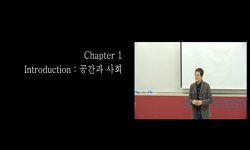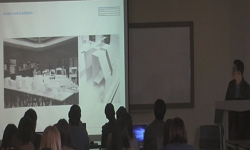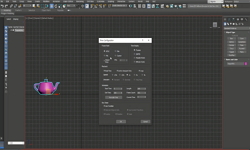본 연구의 목적은 애니메이션 연출에 있어서의 카메라의 역할과 카메라 무브먼트의 개념적 특성을 정의하고, 그 표현의 방법과 의미를 연구 분석하는 데 있다. 디지털 영상 시대에 접어들면...
http://chineseinput.net/에서 pinyin(병음)방식으로 중국어를 변환할 수 있습니다.
변환된 중국어를 복사하여 사용하시면 됩니다.
- 中文 을 입력하시려면 zhongwen을 입력하시고 space를누르시면됩니다.
- 北京 을 입력하시려면 beijing을 입력하시고 space를 누르시면 됩니다.

애니메이션 카메라 무브먼트의 비물질적 특성과 공간 연출 = The Characteristic of Imaginary Camera Movement and Space in Animation
한글로보기https://www.riss.kr/link?id=A101965285
- 저자
- 발행기관
- 학술지명
- 권호사항
-
발행연도
2016
-
작성언어
Korean
-
주제어
비물질적 카메라 ; 카메라 무브먼트 ; 애니메이션 ; 공간 ; imaginary camera ; camera movement ; animation ; space
-
등재정보
KCI등재
-
자료형태
학술저널
- 발행기관 URL
-
수록면
151-160(10쪽)
-
KCI 피인용횟수
1
- 제공처
-
0
상세조회 -
0
다운로드
부가정보
국문 초록 (Abstract)
본 연구의 목적은 애니메이션 연출에 있어서의 카메라의 역할과 카메라 무브먼트의 개념적 특성을 정의하고, 그 표현의 방법과 의미를 연구 분석하는 데 있다. 디지털 영상 시대에 접어들면서 카메라는 더욱 설득력 있는 극적인 도구가 됨과 동시에 ‘카메라이기’를 거부하기 시작하였다. 많은 실사영화에서 카메라 무브먼트는 물리적 카메라로 촬영된 것이 아닌 애니메이팅된 카메라 무브먼트이다. 애니메이션은 처음부터 실제로 존재하는 카메라가 아닌 그려진 카메라의 움직임으로 연출되는 매체였다. 애니메이션에서의 카메라 앵글과 무브먼트는 가상의, 즉 상상의 산물이며, 실재의 카메라가 연출할 수 없는 불가능한 공간을 넘나들며 영화의 극적 효과를 극대화시킨다. 그러나 이러한 상상의 카메라가 단순히 관객의 눈을 즐겁게 하는 시각적 효과만을 위해 쓰여 지는 것은 아니다. 애니메이션에서 카메라 무브먼트는 가상의 공간이 가지고 있는 다의성을 보여주고 나타내며, 이러한 공간은 그 자체가 코드화된 의미작용이 될 수 있다. 따라서 본 연구는 비물질적 카메라의 역할과 의미를 살펴보고, 그것이 가져온 새로운 미학적 영역은 어떠한 것인지를 연구하였다. 또한 2D와 3D 애니메이션에서 카메라 무브먼트의 의미를 각각 정의하고 구체적 사례분석을 통해 최근의 카메라 무브먼트에 대한 개념을 명확히 하였다. 그 결과 애니메이션의 비물질적 카메라 무브먼트는 관객들의 생각과 의식을 확장시키며 카메라에 대한 관습적 개념에 새로운 지각적 경험을 제공한다는 것을 알 수 있었다. 또한 실제 카메라가 재현하지 못하는 공간을 넘나들며 캐릭터의 극적 심리상태와 같은 내러티브의 요소에 적극적으로 개입하고 있다는 것을 알 수 있었다.
다국어 초록 (Multilingual Abstract)
The purpose of this study is to define the role of camera movement and its conceptual characteristics, and to analyze its ways and meanings. Since the digital film era began camera has become a much more powerful tool, but at the same time it has star...
The purpose of this study is to define the role of camera movement and its conceptual characteristics, and to analyze its ways and meanings. Since the digital film era began camera has become a much more powerful tool, but at the same time it has started denying itself as ‘being camera’. Lately camera movements in a number of live action films were ‘animated camera movements’, rather than the ones shot with actual cameras. The animators have used animated camera movements since the beginning of the animation history because it is the distinctive characteristics, which differ it from live action films in production process. The camera movements that are able to go through the impossible places are animated and imaginary in animation, and they maximize the dramatic effect of the film. However, they are not just for the visual fun that entertains audiences. They tell the multiple meanings that the imaginary spaces have, and the spaces themselves could be the coded interactions. Therefore, this paper studied the role and meaning of the imaginary camera movements and the esthetics that they have brought. Also, it defined the meaning of camera movement in both 2D and 3D animation, and clarified its concept through specific examples. As a result, the imaginary camera movements give a new perceptual experiences to audiences and enlarge their thoughts and visions. In addition this research found out that the camera movements involves to the narrative structure like character development as the camera goes back and forth to the impossible places where a physical camera can’t go into.
참고문헌 (Reference)
1 주광명, "영상미학적 접근의 3D 애니메이션 카메라 워킹 연구" 한국디자인학회 18 (18): 209-218, 2005
2 문재철, "디지털 특수효과로서 카메라 무브먼트(movement)에대한 고찰" 한국영화학회 (61) : 117-137, 2014
3 Pierson, R., "Whole-Screen Metamorphosis and the Imagined Camera (Notes on Perspectival Movement in Animation" 10 (10): 2015
4 Gregory, "Visual Illusions Classified" 1 (1): 1997
5 Ferweda, J. A., "Three varieties of realism in computer graphics, In Electronic Imaging" International Society for Optics and Photonics 2003
6 Bazin, A., "The Myth of Total Cinema, What Is Cinema, Vol.1" University of California Press 1967
7 Manovich, L., "The Language of New Media" MIT Press 2001
8 Laybourne, K, "The Animation Book" Three Rivers Press 1998
9 Crafton, D., "Shadow of a Mouse: Performance, Belief, and World-Making in Animation" University of California Press 2012
10 Branigan, "Projecting A Camera: Language-Games in Film Theory" Routledge 2006
1 주광명, "영상미학적 접근의 3D 애니메이션 카메라 워킹 연구" 한국디자인학회 18 (18): 209-218, 2005
2 문재철, "디지털 특수효과로서 카메라 무브먼트(movement)에대한 고찰" 한국영화학회 (61) : 117-137, 2014
3 Pierson, R., "Whole-Screen Metamorphosis and the Imagined Camera (Notes on Perspectival Movement in Animation" 10 (10): 2015
4 Gregory, "Visual Illusions Classified" 1 (1): 1997
5 Ferweda, J. A., "Three varieties of realism in computer graphics, In Electronic Imaging" International Society for Optics and Photonics 2003
6 Bazin, A., "The Myth of Total Cinema, What Is Cinema, Vol.1" University of California Press 1967
7 Manovich, L., "The Language of New Media" MIT Press 2001
8 Laybourne, K, "The Animation Book" Three Rivers Press 1998
9 Crafton, D., "Shadow of a Mouse: Performance, Belief, and World-Making in Animation" University of California Press 2012
10 Branigan, "Projecting A Camera: Language-Games in Film Theory" Routledge 2006
11 Ross, S., "Invitation to the Voyage: The Flight Sequence in Contemporary 3D Cinema" 24 (24): 2012
12 Gregory, "Distortion of Visual Spaces as Inappropriate Constancy Scaling" 199 (199): 1-, 1963
13 Michelson, A., "Bodies in Space : Film as Carnal Knowledge, Artforum" 7 (7): 59-, 1969
동일학술지(권/호) 다른 논문
-
범죄예방 환경설계(CPTED)에 있어서 환경시설물 디자인의 문제점 분석에 관한 연구
- 한국기초조형학회
- 진은미 ( Eun Mi Jin )
- 2016
- KCI등재
-
여성용 셔츠칼라 형태 및 이미지의 실제와 3D 시뮬레이션 비교 연구-DC Suite 5.0 Program을 중심으로-
- 한국기초조형학회
- 차수정(교육원) ( Su Joung Cha )
- 2016
- KCI등재
-
사진작가 버긴의 초기작업(1967-76년): 그 이론적 근거에 대한 비평
- 한국기초조형학회
- 최병길(교수) ( Byung Kil Choi )
- 2016
- KCI등재
-
엑스포 전시공간에 나타나는 미디어의 융합 표현 경향 연구 -2015년 밀라노 엑스포 전시공간을 중심으로-
- 한국기초조형학회
- 최은신 ( Eun Shin Choi )
- 2016
- KCI등재
분석정보
인용정보 인용지수 설명보기
학술지 이력
| 연월일 | 이력구분 | 이력상세 | 등재구분 |
|---|---|---|---|
| 2027 | 평가예정 | 재인증평가 신청대상 (재인증) | |
| 2021-01-01 | 평가 | 등재학술지 유지 (재인증) |  |
| 2018-01-01 | 평가 | 등재학술지 유지 (등재유지) |  |
| 2015-02-09 | 학술지명변경 | 외국어명 : Bulletin of Korean Society of Basic Design & Art -> Journal of Basic Design & Art |  |
| 2015-01-01 | 평가 | 등재학술지 유지 (등재유지) |  |
| 2011-01-01 | 평가 | 등재학술지 유지 (등재유지) |  |
| 2009-01-01 | 평가 | 등재학술지 유지 (등재유지) |  |
| 2006-01-01 | 평가 | 등재학술지 선정 (등재후보2차) |  |
| 2005-01-01 | 평가 | 등재후보 1차 PASS (등재후보1차) |  |
| 2003-01-01 | 평가 | 등재후보학술지 선정 (신규평가) |  |
학술지 인용정보
| 기준연도 | WOS-KCI 통합IF(2년) | KCIF(2년) | KCIF(3년) |
|---|---|---|---|
| 2016 | 0.33 | 0.33 | 0.34 |
| KCIF(4년) | KCIF(5년) | 중심성지수(3년) | 즉시성지수 |
| 0.34 | 0.34 | 0.512 | 0.08 |





 KCI
KCI KISS
KISS





